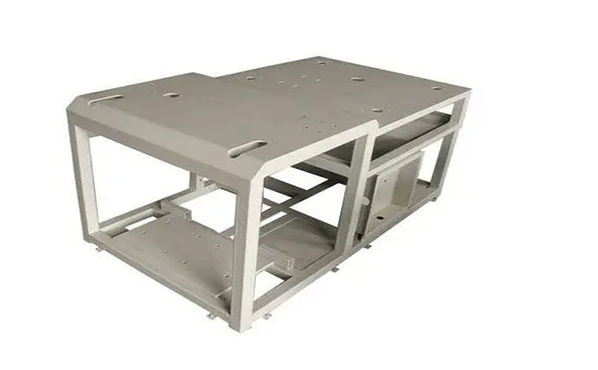Bending is a stamping process that uses pressure to force a material to plastically deform, forming an angled and curved shape. Commonly used bending includes V-bending, Z-bending, back pressure bending, etc.

1. The height of the bend
The bending height of the sheet metal is at least twice the thickness of the sheet metal plus the bending radius, that is, H > 2t R. If the bending height of the sheet metal is too low, it is easy to deform and deform when the sheet metal is bent, and it is difficult to obtain the ideal shape and size.
When it is bent into a hypotenuse, it is most likely to cause bending deformation due to the too small bending height. As shown in the figure, in the original design, since the leftmost bending height is too small, it is easy to twist and deform when bending, resulting in low bending quality. In the improved design, the left bending height can be increased or the part with the smaller bending height can be removed, so that the bending deformation of the sheet metal will not occur and the bending quality will be high.
2. Bending radius
In order to ensure the bending strength, the bending radius should be larger than the minimum bending radius of the material, as shown in the following figure:
The original improved bending radius design of sheet metal is shown in the following figure:
The larger the bending radius of the sheet metal, the better, the larger the bending rebound, and the more difficult it is to control the bending angle and bending height. Therefore, the sheet metal bend radius needs a reasonable value.
Sheet metal mold manufacturers tend to have a bending radius of 0, so it is not easy to rebound after bending the radius, and the dimensions of the bending height and bending angle are easier to control. However, the zero bending radius can easily lead to cracking or even breaking the outside of the sheet metal bending, and the bending strength of the sheet metal is relatively low, especially for hard sheet metal materials. After a period of time, the right angle on the mold gradually becomes smooth, and the bending size is difficult to control.
In order to reduce the bending force and ensure the bending size, another method adopted by sheet metal mold manufacturers is to increase the crimping process before the bending process. Of course, this design results in a relatively low bending strength of the sheet metal, which is prone to breakage.
In order to reduce the bending force and ensure the bending size, another method adopted by sheet metal mold manufacturers is to increase the crimping process before the bending process. Of course, this design results in a relatively low bending strength of the sheet metal, which is prone to breakage....
3. Bending direction
Sheet metal bends should be as perpendicular to the metal fiber direction as possible. When the sheet metal is bent parallel to the direction of the metal fibers, cracks are prone to occur at the bending of the sheet metal, the strength is low, and it is easy to break.
4. Avoid bending failure due to no pressing material at the bending root
When the sheet metal is bent, because other characteristics are too close to the base of the sheet metal bending, it is often impossible to compress the material, and it cannot be bent or severely deformed. In general, keep at least twice the thickness of the metal sheet above the root of the bend, and there are no other characteristics between the bend radii to prevent the metal sheet from bending.
As shown in the figure below, in the original design, the reverse bending position is too close to the bending root of the sheet metal, which causes the bending of the sheet metal to fail. As shown in the figure below, the tooth of the sheet metal is too close to the bending root, resulting in bending, and the tooth can be moved away from the sheet metal For the root, if the teeth and the bending position cannot be moved due to the design requirements, a process incision can be added to the corresponding bent root to ensure the smooth progress of the bending.
5. Ensure bending clearance and avoid bending interference
Due to the existence of sheet metal bending tolerances, it is necessary to ensure a certain bending gap in the direction of movement of sheet metal bending to avoid bending failure caused by interference during the bending process.
As shown in the image above, the bending sequence of the part is to bend on the top side first, then on the right side. In the original design, there was no gap between the two bends. When the upper side is bent and the right side is bent, it is likely to interfere with the right side and the upper side during the bending process due to sheet metal bending tolerances. In the improved design, at least a 0.2mm gap between the right side and the upper side is reserved, which can effectively avoid interference.
6. Guaranteed bending strength
Sheet metal bending needs to ensure the bending strength. The bending strength of the long and narrow is low, and the bending strength of the short width is high. Therefore, the sheet metal bending is attached to the longer edge as much as possible. As shown in the figure, the bending function is the same. The original design is because the bending is attached to the shorter edge. The edge has low flexural strength, and the improved design bends attached to the longer edge with high flexural strength.
7. Reduce the bending process
The more sheet metal bending processes, the higher the mold cost and the lower the bending accuracy. Therefore, the sheet metal design should minimize the bending process. As shown, the sheet metal required two bending processes in the original design. In the improved design, the sheet metal requires only one bending process to complete two bends at the same time.
8. Avoid complex bends
The more complex the sheet metal bending process, the higher the mold cost, the lower the bending accuracy, and the complex bending may cause waste of part material. Therefore, when the sheet metal bending is complex, it can be considered to divide the complex bending into two parts by pulling studs, self-riveting or spot welding.
9. Multiple curved holes are difficult to align

Sheet metal bending tolerances are large, especially when multiple bends are made, and the accumulation of tolerances makes hole-to-hole alignment difficult.
The more the sheet metal is bent, the larger the bending tolerance. The multiple bending of sheet metal is difficult to ensure the accuracy of dimensions, which is also the reason why it is difficult to align screw holes, rivet holes and self-riveting holes on sheet metal bending.
solution:
Design the hole on the bend as a large hole or an oblong hole to make the tolerance larger.
Adding two inner positioning holes, the mold increases the inner positioning, reduces the tolerance when the sheet metal is bent, and ensures that the two bending holes are aligned.
Bending before punching can ensure the dimensional accuracy of the two holes, but it is generally not recommended to increase the complexity and cost of punching dies.



